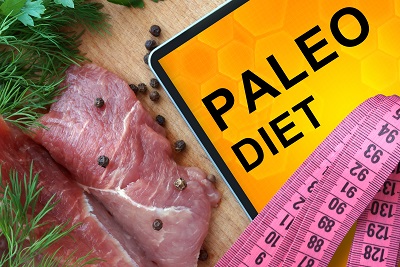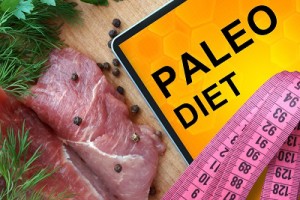The Pros and Cons of the Paleo Diet
By Chris Newport, Nutritionist and Head Coach
There are a million “diets” out there. Seriously. Just scroll through Amazon, walk through your favorite bookstore, or talk to your friend who’s on the latest craze. In fact, I often hear about the latest trends through my clients (or social media). It can vary from multi-level marketing diets, juice cleansing, and everything in between. Many of my clients have tried the Paleo Diet (mostly unsuccessfully, by the way), which in 2013, was Google’s most-searched-for weight loss method. So here are some important things to consider when evaluating this diet and whether it’s right for you.
What is the Paleo Diet?
While the roots of eating like our paleolithic ancestors can be traced back to the 1970s, this has most recently been popularized by the Dr Loren Cordain in his book The Paleo Diet. The theory behind the Paleo diet is that the human genome developed on this style of eating, which is best for our biological design. Therefore, it can decrease the risk of disease and improve human performance. However, it’s difficult to define a single Paleo diet because there are widely different diets of Paleolithic humans when considering where people were located. I love this TED talk called Debunking the Paleo Diet by Christina Warinner, an archaeological scientist, someone who studies the diets of ancient peoples using bone biochemistry and ancient DNA.
What’s NOT on the Paleo Diet?
A lot. It eliminates:
- all grains (wheat, rye, barley, millet, rice, corn, quinoa, etc)
- soy (tofu, tempeh, edamame, soymilk, etc)
- legumes (black beans, pinto beans, peanuts, etc)
- dairy (milk, yogurt, cheese, etc)
- processed oils (canola, soy, cottonseed, etc)
- refined sugar, artificial sweeteners, and chemicals (including processed foods)
- starchy vegetables (like white potatoes)
What IS on the Paleo Diet?
Hello, bacon and butter! You can rock out lots of meats (grass-fed, preferably), fish, seafood, fruits, veggies, eggs, nuts, seeds, natural sweeteners (like honey and maple syrup), and “healthy” oils (coconut, avocado, etc).
No matter what style of eating or “diet” you’re investigating, always weigh the pros and cons. Everyone is different. So here are a few good things about the Paleo Diet:
Paleo Diet Pros:
- It focuses on eating whole, real foods.
- There are minimal refined sugars and carbohydrates, which is great for preventing disease (or even healing it). The current, limited research suggests some benefit on body composition, blood lipids, and markers of glucose tolerance (in diseased participants).
- It retrains your taste buds (and brain) to prefer less sweet foods.
- It encourages mindfulness about your food, including where it comes from and how to prepare it (more cooking!).
- It’s great for anyone allergic or sensitive to wheat, gluten, soy, dairy or peanuts.
- It can be beneficial for weight management.
- It eliminates potentially inflammatory foods like gluten and diary (although this isn’t always the case). Here’s a TED Talk by Dr. Terry Wahls, who treated her MS with this dietary approach called Minding Your Mitochondria.
Paleo Diet Cons:
- It’s restrictive, which means it can be
- difficult to travel
- difficult to dine out
- difficult to adhere to
- There are contradictory or conflicting info on paleo diet “rules” and science. Dairy’s not ok, but ghee is? Anytime a diet is popular, you’re going to see tons of variations on a theme and often not enough science behind big claims. For example, in his book, Cordain cited an animal study to support their hypothesis that peanuts and peanut oil are highly atherogenic because of their lectin content. The study was performed on rabbits and monkeys, not humans. The animals were fed peanut oil. For a human that was consuming this type of meal would represent an intake of about 42,800 mg of cholesterol/day. Furthermore, the dietary lifestyle habits of four populations with high numbers of centenarians (people over 100 years old) ate mostly cereal grain or starch as the basis of their diet and meat intake was little to none.
- Certain foods may be difficult to find like duck fat, grass-fed meats, coconut butter, etc.
- It may be hard to maintain for endurance athletes, particularly long course (half iron distance, ulra endurance, etc) training and racing. Are you going to race with carrot sticks and sweet potatoes in your back pocket? Perhaps, but it may not provide enough carbohydrates. And the carbohydrates it does provide might get boring and lack variety.
- It can be expensive.
- It can be short on certain nutrients. One study showed calcium intakes below 50% of the recommended 1000 mg/day.
Bottom Line:
While there are many “holes” in the current Paleo Diet theory, this style of eating may be beneficial for many people and focuses on eating whole foods and reducing processed foods and added sugar. However, the diet can be overly restrictive, particularly for endurance athletes. Not every diet is right for every body. Be sure to focus on getting a very diverse diet. 99% of people who step into my office eat the same breakfast every day. And the people who have tried this diet tend to do the same thing. So regardless of what diet you choose, get plenty of diversity and focus on whole, fresh foods.
Resources:
Debunking the Paleo Diet by Christina Warinner. An evidence-based approach from an archaeological scientist, someone who studies the diets of ancient peoples using bone biochemistry and ancient DNA.
Minding Your Mitochondria by Dr Terry Wahls. A doctor who treated her MS using this dietary approach.
How to Really Eat Like a Hunter Gatherer: Why the Paleo Diet is Half Baked from Scientific American
How the Paleolithic Diet Got Trendy, a fun article in the New Yorker by a woman who ate “Paleo” for a week.
Against the Grain by Nancy Cain. While this book isn’t truly Paleo, there are some great recipes in here that I personally love.
Danielle Walker’s Against All Grain and Against All Grain by Danielle Walker, two books with more great recipes.
Practical Paleo by Diane Sanfilippo. While this is a great resource, I think many people may practice “green medicine” with this one, diagnosing themselves with certain conditions then attempting to treat themselves with the suggested supplements. Always talk to your healthcare provider before embarking on a supplement routine!
Grain Brain by Dr David Perlmutter
The Blood Sugar Solution by Dr Mark Hyman
Thanks to our awesome intern Laura Thomas for her contributions to this article!





